25 Types of Trees in California (With Pictures)
-
Elizabeth Gray
- Last updated:

California may be famous for its beaches and farmland, but the state also boasts many forests and mountain ranges. If you’ve ever wondered what types of trees make their home in this state, you’ve come to the right place. In this article, you will find details about 25 types of trees in California. We cover both deciduous and evergreen trees, broken up by category.

The 25 Types of Trees in California
Deciduous Trees
1. Blue Oak

| Scientific name: | Quercus douglasii |
| Height: | 45-60 feet |
| Growth Rate: | Very slow |
Blue oak is a hardy, slow-growing tree found primarily on wooded hills in California, from Los Angeles to the north of San Francisco. They don’t require much water and grow best in dry soil, allowing them to thrive in the state’s climate. The oak’s blue-green leaves don’t change color in autumn but do fall off. If the summer has been particularly dry, the blue oak may lose its leaves sooner. It produces acorns about one inch in length.
2. Valley Oak
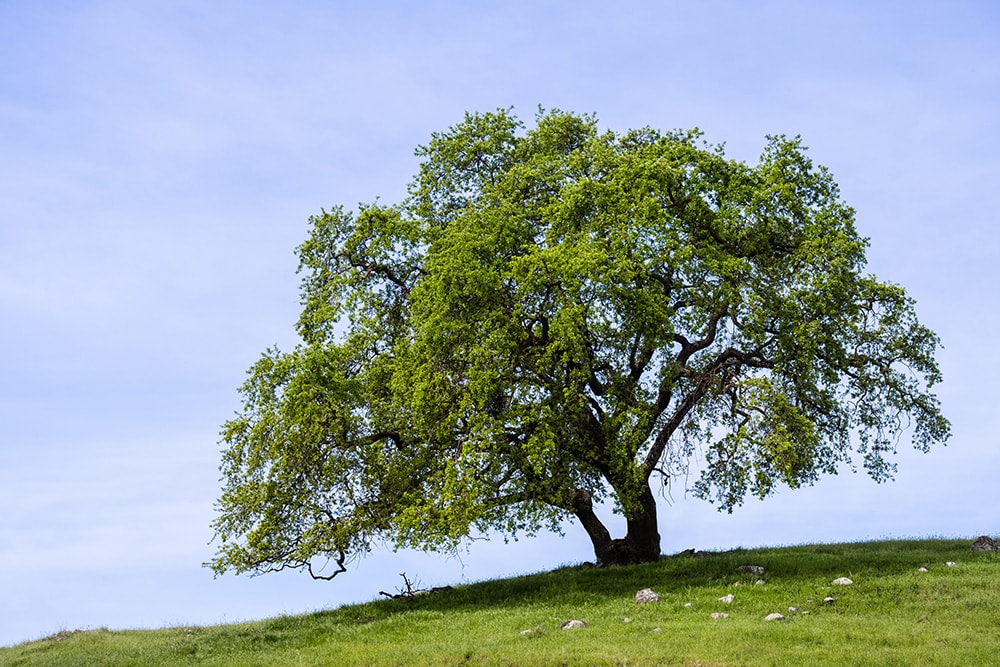
| Scientific name: | Quercus lobata |
| Height: | 50-80 feet |
| Growth Rate: | Moderate to fast |
This tree is the largest oak species found in North America. The valley oak grows quickly in a range of different soils. It is drought-tolerant and produces intricate tangled branch patterns, making it one of the most lovely trees in California. The leaves turn yellow in the fall before dropping. As its name suggests, this tree prefers valley locations rather than higher elevations. Valley oaks serve as a habitat and food source for local wildlife.
3. California Buckeye
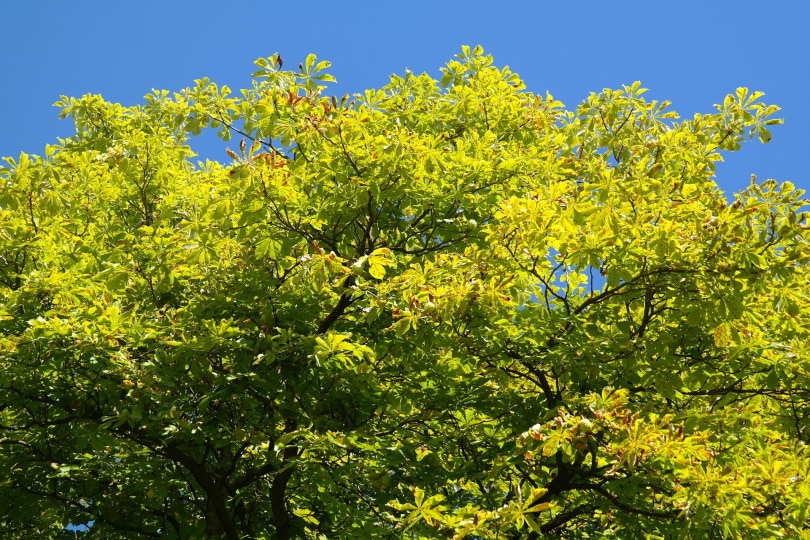
| Scientific name: | Aeculus californica |
| Height: | 30-50 feet |
| Growth Rate: | Moderate |
This medium-sized tree produces sweet-smelling white flowers, which attract local California pollinator species. It is the only buckeye species native to the state. The California buckeye has low water needs and loses its leaves early in the summer, allowing it to use even less liquid. The tree grows brown fruit 2-3 inches in size that should not be eaten. The flowers of the tree are also toxic to honeybees. California buckeyes are located in most areas of the state.
4. California Sycamore

| Scientific name: | Platanus racemosa |
| Height: | 50-80 feet |
| Growth Rate: | Fast |
The California sycamore is found primarily in wetland and river areas, and it’s a tall tree that can grow as much as 3 feet each year. Sycamores are well-known for their gray and white peeling bark. The trees are most common from the Mexican border to the north of Sacramento. California sycamores need more water than many native trees, which is why they are primarily found in wetter habitats. Once they’ve grown large enough, the trees can tolerate drier conditions but do best if watered at least once per week.
5. Western Redbud
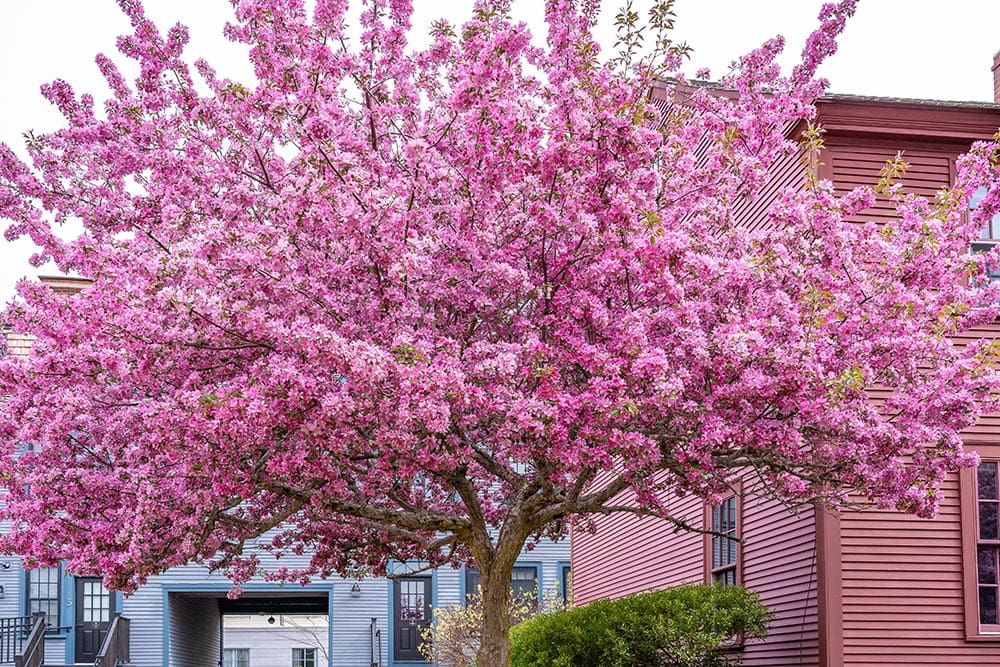
| Scientific name: | Cercis occidentalis |
| Height: | 15-20 feet |
| Growth Rate: | Moderate to fast |
The Western redbud is a gorgeous ornamental tree featuring beautiful pink-purple flowers that are among the earliest spring bloomers. This tree is easy to grow, with low water needs. In the wild, it prefers sloping elevations in the hills and mountains. Western redbuds are most common in the northern part of the state because they require cooler temperatures to thrive. In the fall, the leaves turn bright gold before falling.
6. California White Alder
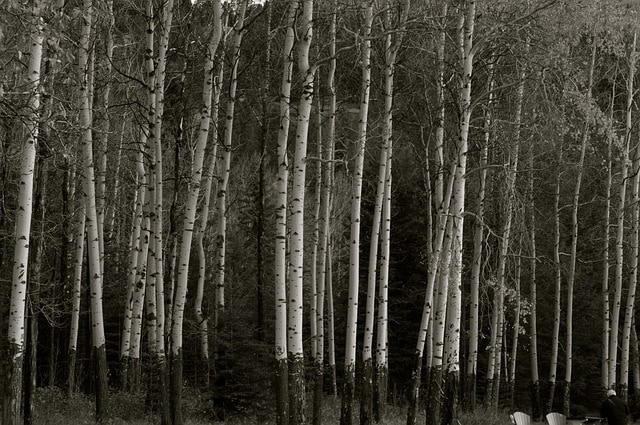
| Scientific name: | Alnus rhombifolia |
| Height: | 49-82 feet |
| Growth Rate: | Fast |
The California white alder is found throughout the state, from San Diego up past the northern border. It can grow at various altitudes but prefers moist soils such as creek beds or river banks. The tree produces green and white flowers, which mature into a fruit that looks like small pine cones. In the spring, the California white alder produces huge amounts of pollen, which is unfortunate for allergy sufferers in the state. The tree’s massive roots system can wreak havoc on pipes and foundations.
7. Box Elder
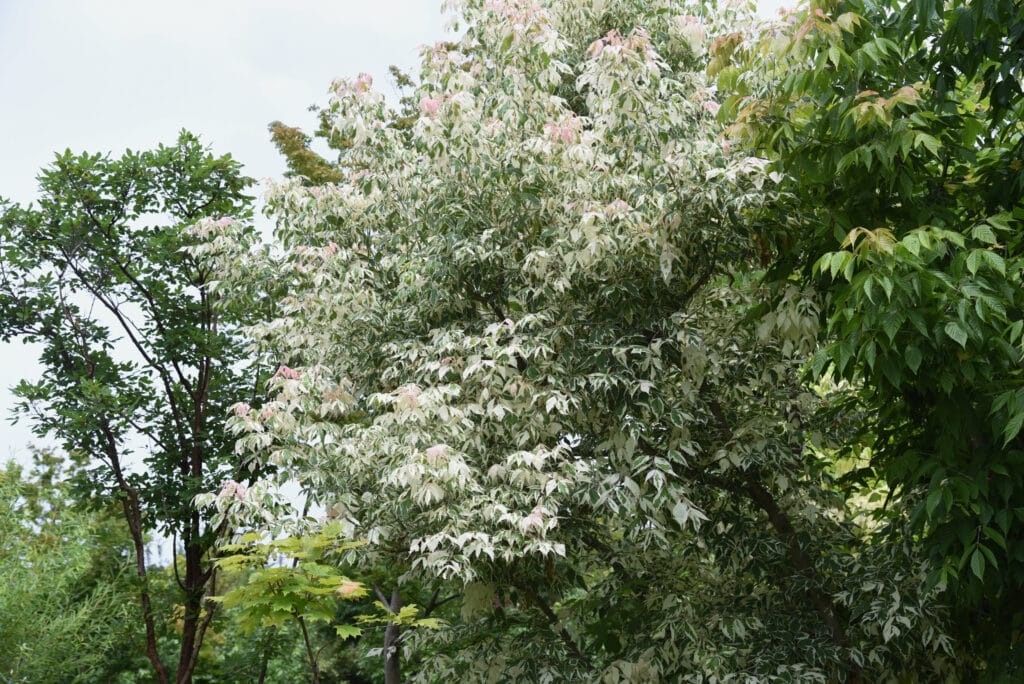
| Scientific name: | Acer negundo |
| Height: | 35-66 feet tall |
| Growth Rate: | Fast |
The box elder is known by several other names, including maple ash and boxelder maple. In California, the tree is found in coastal mountain ranges from San Diego to Sacramento. This species prefers moist planting locations, such as near streams. Older trees are more drought-tolerant because their roots can typically reach underground water sources. The trees attract many different bird and insect species and are fairly easy to grow. The leaves turn a glorious range of colors in the fall, from yellow to a mix of red and yellow.
8. Fremont Cottonwood
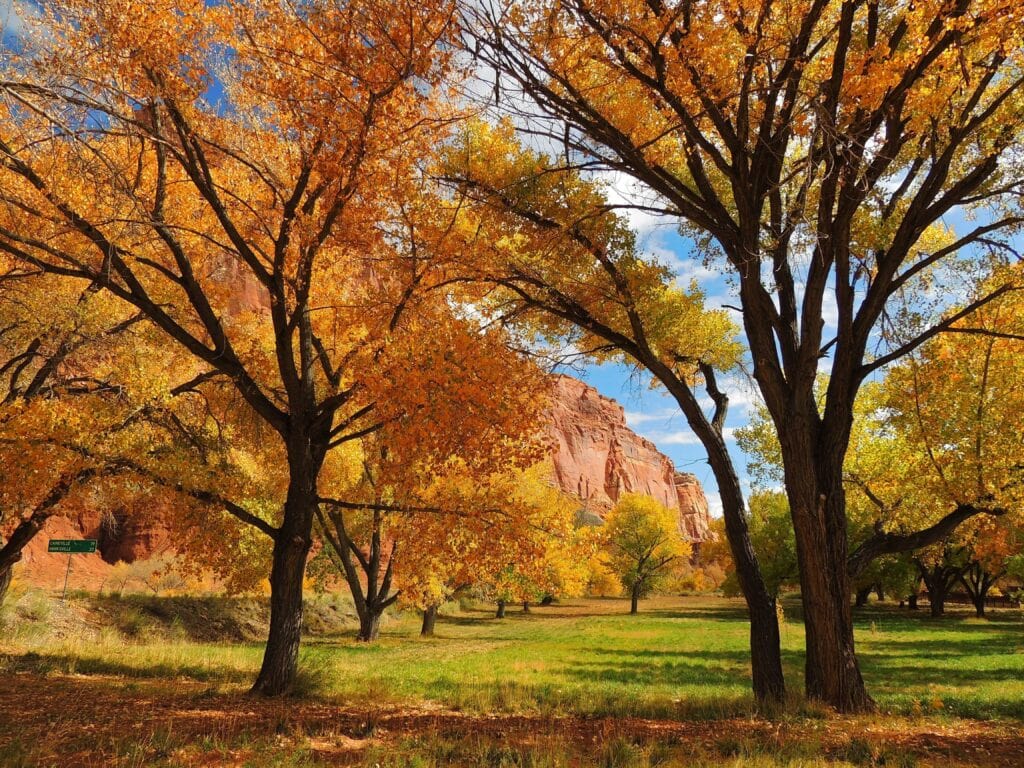
| Scientific name: | Populus fremontii |
| Height: | 39-115 feet |
| Growth Rate: | Fast |
The Fremont cottonwood is a fast-growing, very tall tree that is found near water sources throughout most of the state. They prefer sunny locations with moist soil and can grow up 10–20 feet in a single year. The tree gets its name from the appearance of the fruit, which looks like cotton tufts hanging from the branches. Although this tree is easy to grow, it requires a lot of extra water if not planted near a natural moisture source.
9. California Black Walnut
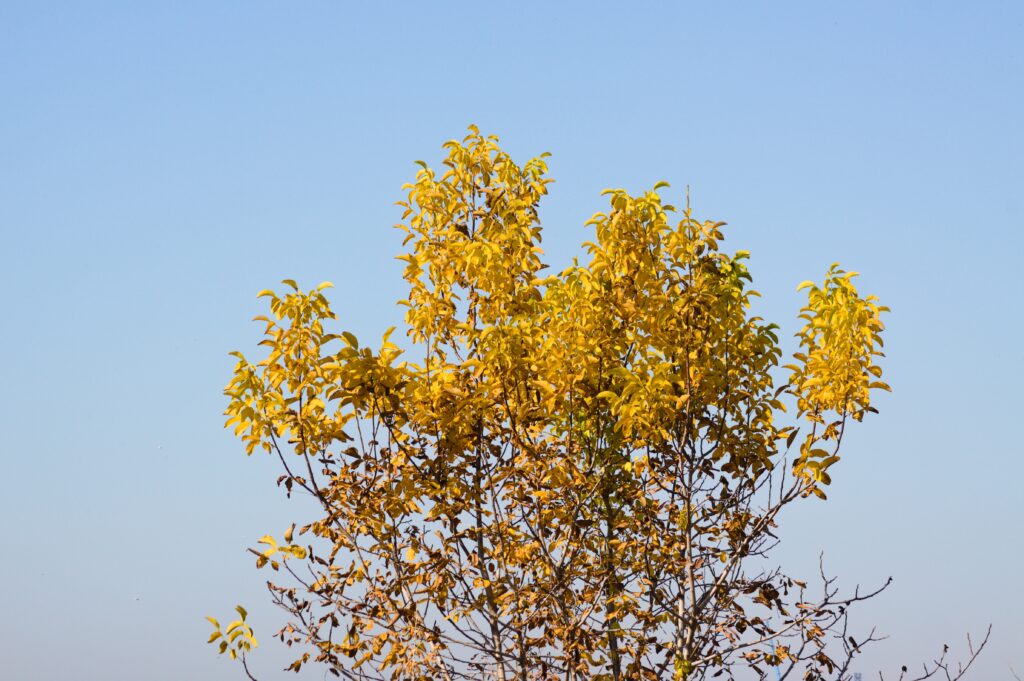
| Scientific name: | Juglans californica |
| Height: | 50-75 feet tall |
| Growth Rate: | Moderate |
This tree is primarily found in Southern California, with some trees near Sacramento. The California black walnut is threatened by human development in the southern part of the state. It prefers to grow in moist soil and can tolerate partial shade, and its walnuts are a vital food source for many birds and wildlife. Because the tree doesn’t grow very tall, it’s a good option for those looking to increase the wildlife habitat on their property, especially since planting it also helps save the native population.
10. Oregon Ash
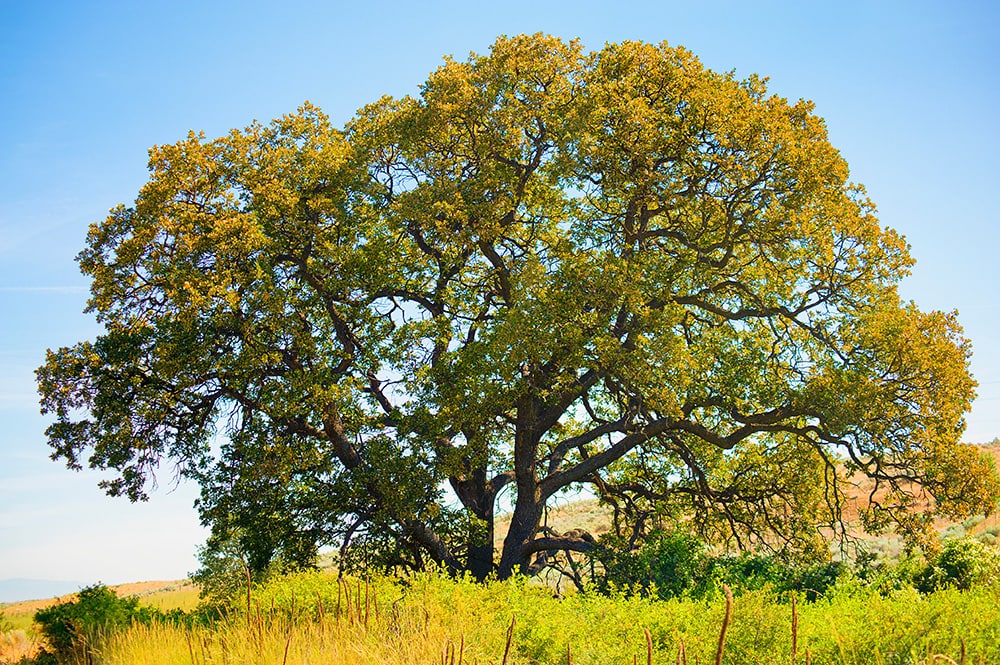
| Scientific name: | Fraxinus latifolia |
| Height: | 60-80 feet |
| Growth Rate: | Fast |
The Oregon ash is found primarily in Northern and Central California near rivers and streams. It thrives in the poorly drained soil common in these areas. The Oregon Ash grows fast when it is young but will slow down once it is fully mature. The tree is easy to care for, attracts many beautiful butterfly species, and can live as long as 250 years.
11. Sandbar Willow
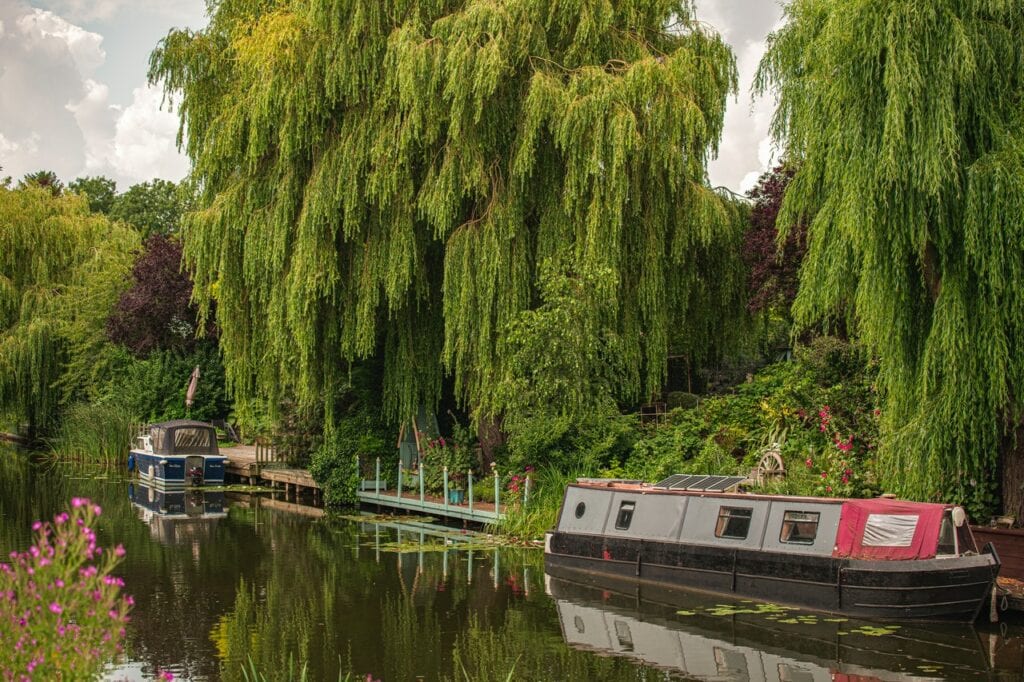
| Scientific name: | Salix exigua |
| Height: | 10-23 feet tall |
| Growth Rate: | Moderate to fast |
This widespread tree is located in every county in California. The sandbar willow is a small tree or shrub that prefers moist soil, like most willow trees. It does not tolerate drought and will need extra watering in the summer months. If planted near a pond or stream, the tree will spread by sending out new shoots into the wet soil. This willow is very attractive to pollinator species, including butterflies and moths. It also serves as a nesting habitat for several bird species.
12. Big Leaf Maple
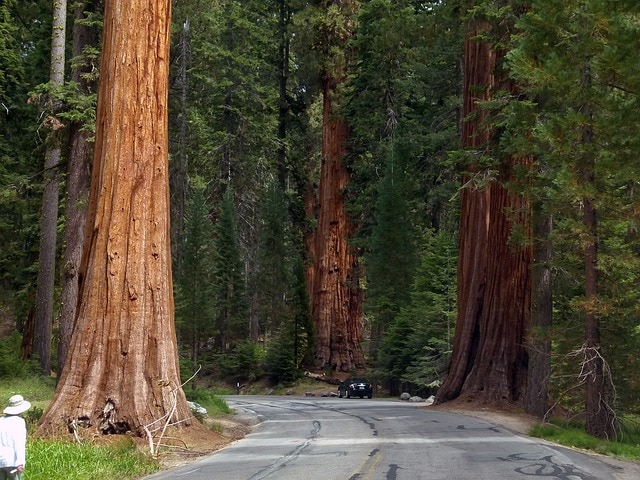
| Scientific name: | Acer macrophyllum |
| Height: | 30-115 feet |
| Growth Rate: | Fast |
The big leaf maple is found mainly along the California coast but also in the foothills of the Sierra Nevada mountains. It grows very quickly and can tolerate partial shade. The big leaf maple can grow in most types of soil and drainage levels, although it does thrive in sandy soil. The tree attracts many birds and insects, and its leaves will change color in the fall as long as the temperature gets colder.
13. Water Birch

| Scientific name: | Betula occidentalis |
| Height: | 25-33 feet tall |
| Growth Rate: | Moderate to fast |
Water birch is a small, shrub-like tree that occurs sporadically throughout California. Populations can be found in the Southern Sierra mountains and the northern part of the state. The tree prefers mountain habitats, typically occurring at an elevation of 2,000 to 11,000 feet. Water birch grows best in moist to wet soil, usually along mountain creeks. It produces vivid fall colors when exposed to cold autumn weather. Water birch is easy to grow and attracts several species of insects.

Evergreen Trees
14. Coast Live Oak
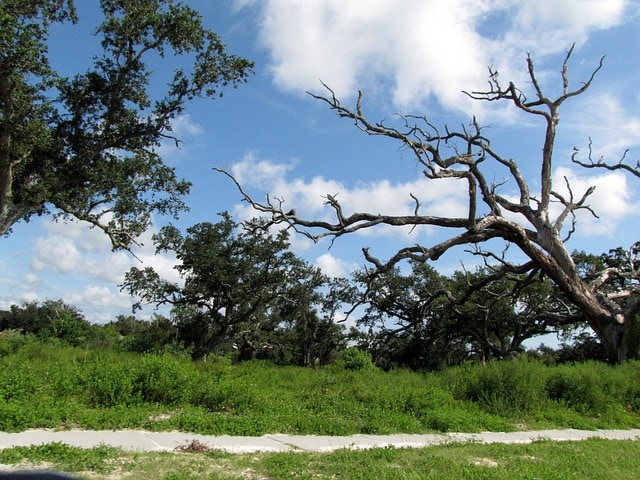
| Scientific name: | Quercus agrifolia |
| Height: | 25-82 feet |
| Growth Rate: | Slow-moderate |
The coast live oak maintains its dark green leaves year-round while producing yellow-cream flowers in the spring and reddish-brown acorns in the fall. It grows west of California’s central valley. It is one of the few California oaks that thrive near the coast because it is fairly tolerant of salty air and enjoys warm weather. The coast live oak is easy to grow, with reasonable water requirements. You’ll want to keep the roots shaded, especially when the trees are young, by providing a thick layer of mulch or rocks.
15. Catalina Cherry
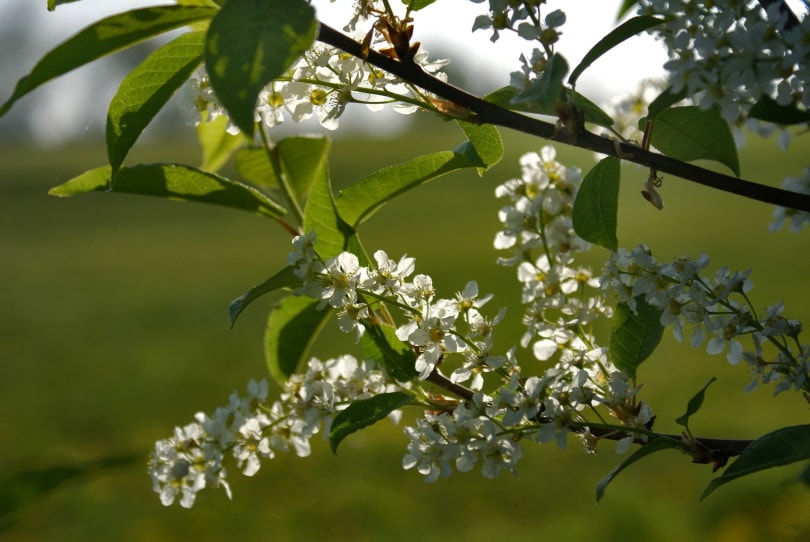
| Scientific name: | Prunus illicifolia ssp. lyonii |
| Height: | 25-40 feet |
| Growth Rate: | Moderate to fast |
This fruit-bearing tree is native to Central and Southern California, mainly the Channel Islands region. The Catalina Cherry holds onto its shiny green leaves all year, producing lovely white flowers in late spring. Birds adore the fruit of this tree, which is edible but not particularly tasty for humans. It grows well in different soils, tolerates partial shade, and sometimes cross-pollinates with other cherry trees. The juice of the cherry stains concret, so be aware when choosing a planting location.
16. Foothill Pine

| Scientific name: | Pinus sabiniana |
| Height: | 20-80 feet |
| Growth Rate: | Slow |
Foothill pines are located primarily in Southern, Central, And Northern California. They can grow in habitats up to 4,500 feet in elevation, but they are slow-growing in the wild, adding height during the spring and summer months only. When cultivated and watered frequently, the foothill pine grows faster. It is very easy to care for and commonly used in landscaping. The tree produces fragrant yellow flowers in the spring and attracts many insects and other creatures.
17. Hickory Pine
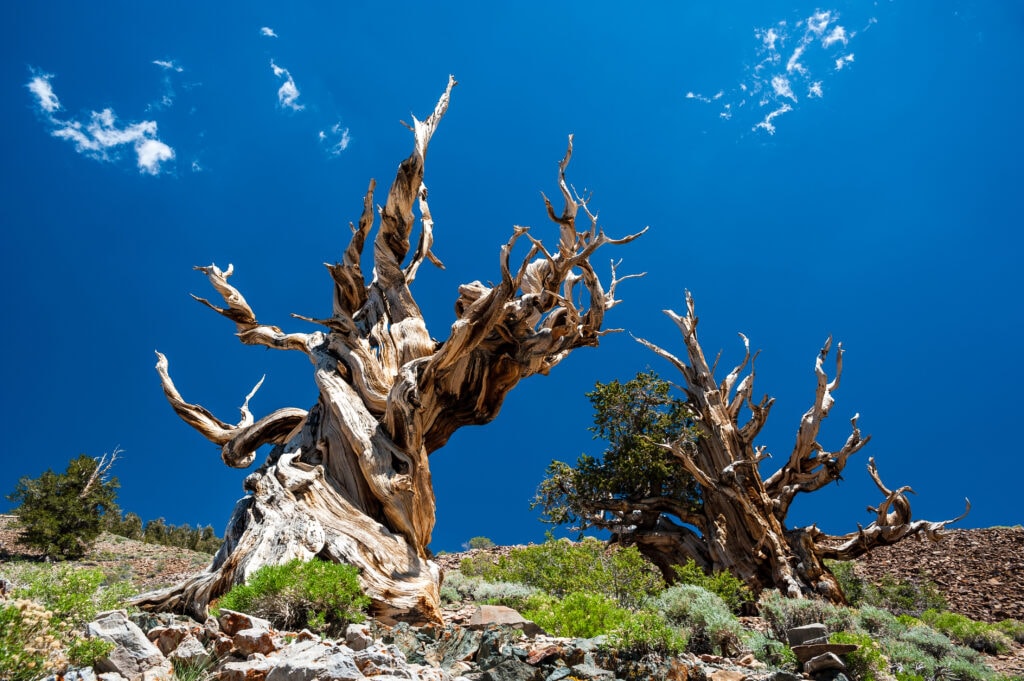
| Scientific name: | Pinus longaeva |
| Height: | 16-52 feet |
| Growth Rate: | Slow |
This species is one of three closely related pines known as bristlecone pines. The hickory pine is also called the Great Basin bristlecone pine or Western bristlecone pine. In California, it’s found only in the higher elevations of the Sierra Nevada mountain range, growing on mesas, slopes, and mountain tops. It grows slowly, and the tree’s needles often remain green for 45 years. Hickory pines attract and host many different insect species, including those that bore into its bark.
18. Interior Live Oak
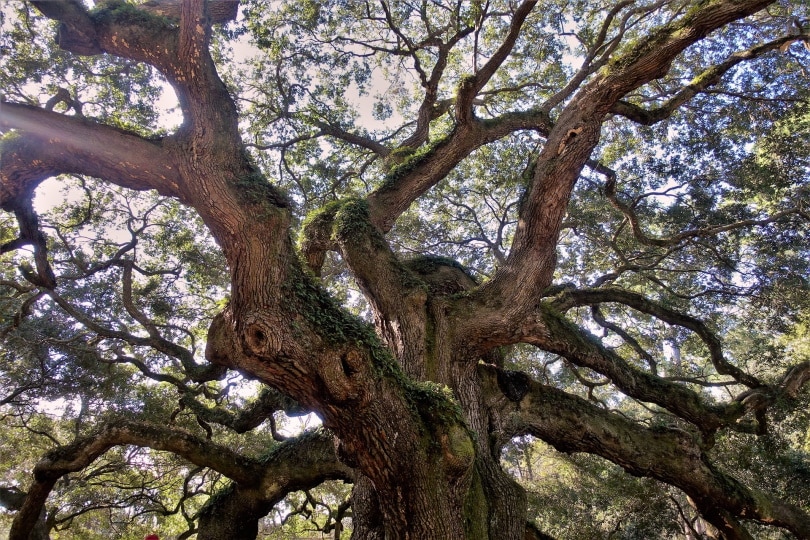
| Scientific name: | Quercus wislizeni |
| Height: | 15-50 feet |
| Growth Rate: | Moderate |
The interior live oak grows along the California coast, coastal mountain ranges, Central Valley, and Sierra foothills. The thick green leaves remain on the tree year-round, and the acorns of the interior live oak are pointed, long, and take a full two years to mature. This tree is easy to grow and tolerates various soil types and drainage levels. Several birds and insects rely on the tree, and it is one of the most common oaks found in the foothill forests.
19. Incense Cedar
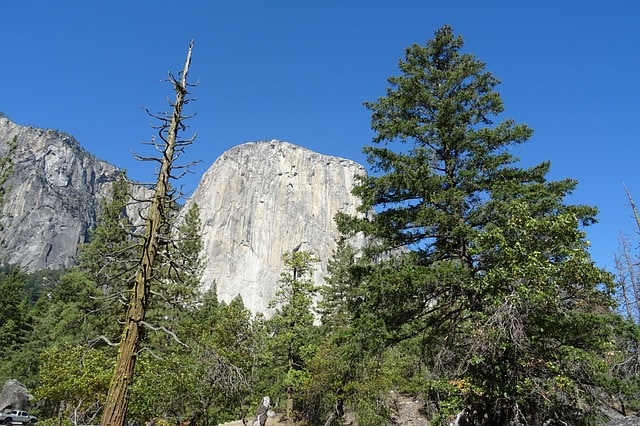
| Scientific name: | Calocedrus decurrens |
| Height: | 12-197 feet |
| Growth Rate: | Slow-moderate |
The incense cedar can be found throughout much of California and is easy to grow as long as you have sufficient space for it. It can be trained to be drought-tolerant by minimizing watering during the early years of its growth. Incense cedars prefer soil rich in organic material, such as that found in forests, and they can be grown in full sun or partial shade. Numerous insects and birds gravitate towards the Incense Cedar, and it is often used to create hedges.
20. Lodgepole Pine
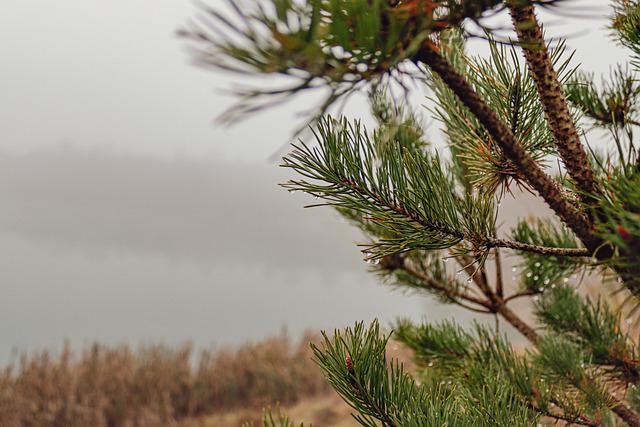
| Scientific name: | Pinus contorta |
| Height: | 30-112 feet |
| Growth Rate: | Fast |
The lodgepole pine is a fast-growing evergreen found primarily in California’s Sierra Nevada mountain range. A sub-species also occurs near the coast and is known as the beach pine, and it can grow in different soil conditions and tolerates partial shade. The Lodgepole Pine is an important tree for numerous wildlife, bird, and insect species. It’s harvested for timber and is vulnerable to wildfires because of its thin bark.
21. Canyon Live Oak
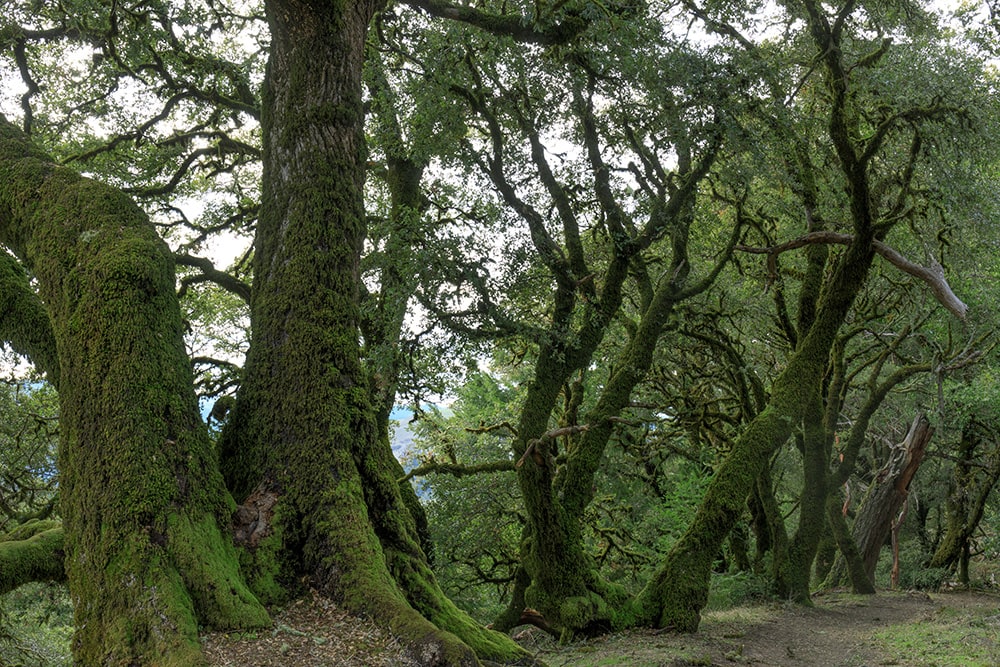
| Scientific name: | Quercus chrysolepis |
| Height: | 30-90 feet |
| Growth Rate: | Slow to moderate |
This species is the most widespread oak found in California. Canyon live oaks inhabit the coastal mountain ranges as well as the Sierra Nevadas. It generally grows near creeks in cool, moist environments and tolerates all light conditions, including full shade. Canyon live oaks regenerate themselves after surviving wildfires. Wildlife, reptiles, amphibians, birds, and insects are all attracted to the trees. They are an old species, and fossilized specimens of the tree have been discovered. Native American tribes historically relied on the acorns as a food source.
22. Mountain Mahogany
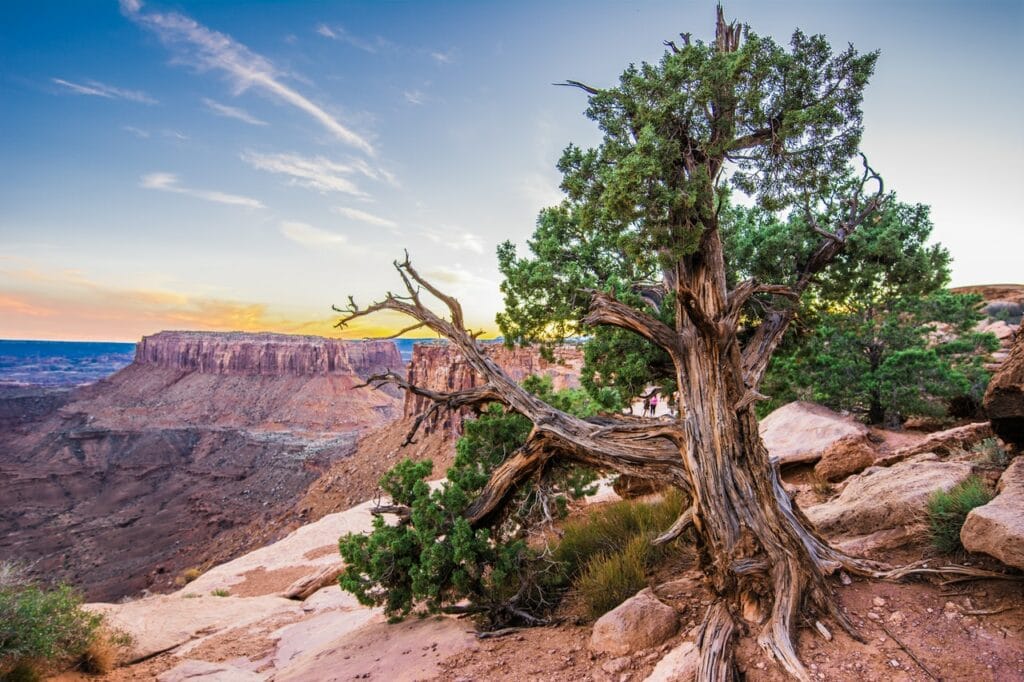
| Scientific name: | Cercocarpus betuloides |
| Height: | 8-20 feet |
| Growth Rate: | Moderate to fast |
Mountain mahogany is a small, shrub-like tree that grows in the dry foothills and mountain regions of California. It has minimal water requirements and adapts to most soil conditions. This relatively fast-growing species is often grown as a hedge or screening tree. Mountain mahogany tolerates pruning well, allowing it to be shaped to fit even tight spaces. The broad root system of this tree also makes it an excellent choice for erosion control. The reddish wood of the mountain mahogany is very hard and used to make tools and arrows by Native Americans.
23. Baja Birdbush
| Scientific name: | Ornithostaphylos oppositifolia |
| Height: | 15 feet |
| Growth Rate: | Slow |
This small, slow-growing tree is extremely rare: found only in San Diego County near the Mexican border, and the tree’s wild population is under threat due to border enforcement actions. The Baja birdbush is drought-tolerant, easy to care for, and produces beautiful white flowers. The gorgeous plant is a fantastic choice for yard and garden planting due to its small size and attraction to hummingbirds and other feathered species. It prefers full sun and well-drained soil.
24. Coast Redwood

| Scientific name: | Sequoia sempervirens |
| Height: | 60-380 feet tall |
| Growth Rate: | Fast |
One of the most iconic California species, coast redwoods are also known to produce the tallest trees on earth. The giant evergreens are native to the California coast, from the central region up past the Oregon border. They grow best in areas with wet winters and cool summers, relying on fog for part of their moisture intake. The trees can live for more than 2,200 years, reaching enormous heights and widths in the process. Coast redwoods are sensitive to poor air and water quality, making pollution one of their biggest threats. The giant trees are relatively easy to grow in a suitable climate but tend to outgrow the average backyard quickly!
25. Giant Sequoia

| Scientific name: | Sequoiadendron giganteum |
| Height: | 35-311 feet |
| Growth Rate: | Slow |
Also called Sierra redwoods, giant sequoias are the other famous (and enormous) California trees. While they are related to coast redwoods, giant sequoias are prevalent on the other side of the state in the dry Sierra Nevada Mountains. The trees grow at higher elevations, generally between 4,600–8,400 feet. In terms of height and width, giant sequoias produce the largest trees on earth, growing to over 300 feet tall and 50 feet wide. They’re also ancient, and the oldest known specimen is believed to be more than 3,500 years old. These evergreen trees also produce enormous amounts of cones and seeds, which they use to reproduce. A large tree can carry 11,000 cones and spread 300,000–400,000 seeds annually.

Final Thoughts
Like so many others in the world, California trees often fall victim to human development and expansion, especially in a state desperately needing more housing options. Californians who want to do their part to support their local ecosystems should consider planting one of the many native trees on our list of 25. Even if you don’t have room for a redwood in your front yard, plenty of other choices can provide food and shelter for birds and wildlife, along with flowers ripe for pollination.
Featured Image Credit: Paul Hanaoka, Unsplash
Contents